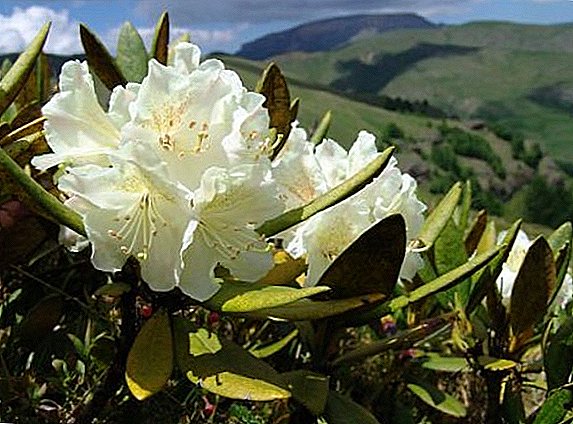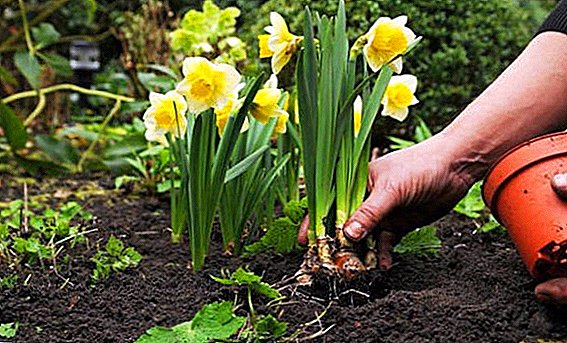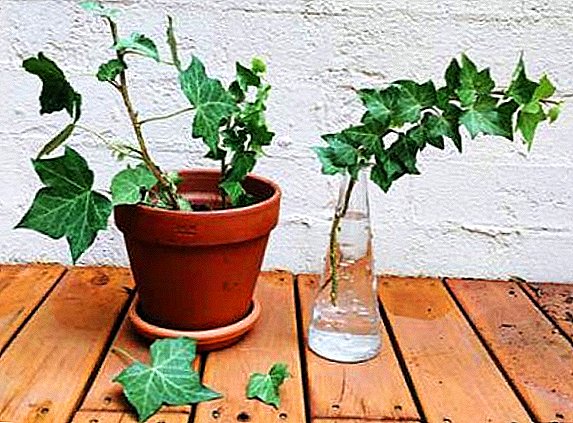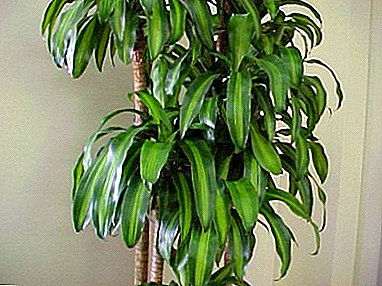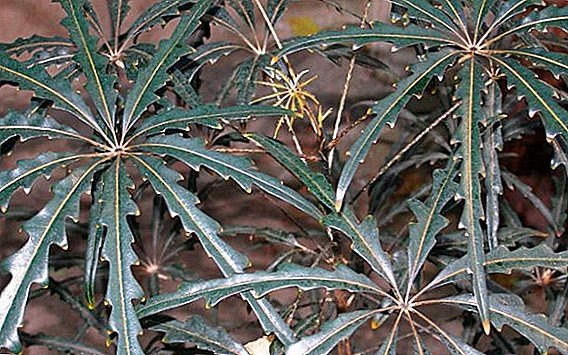 Houseplants are a necessary element in every home - with the help of these small green inhabitants of the window sill you can significantly change the air quality, increase its oxygen saturation and eliminate the harmful effects of computer equipment. Today we will talk about such a houseplant as dizigoteka - learn how to grow it properly at home, what are the features of care and reproduction.
Houseplants are a necessary element in every home - with the help of these small green inhabitants of the window sill you can significantly change the air quality, increase its oxygen saturation and eliminate the harmful effects of computer equipment. Today we will talk about such a houseplant as dizigoteka - learn how to grow it properly at home, what are the features of care and reproduction.
Description
This ornamental herb is not the most frequent inhabitant of window sills of gardeners - it is quite capricious and requires special care. Dizigoteka belongs to the Araliyev family, and the first copies of this species were found on Pacific islands (in particular, Polynesia).  This is a perennial evergreen deciduous plant, which in a closed room can grow up to 1.5 m in height.
This is a perennial evergreen deciduous plant, which in a closed room can grow up to 1.5 m in height.
This small shrub has unusual leaves - they are dissected at the sides, have small teeth and resemble palm leaves. Often these teeth are framed in a contrasting light shade.
Decorative grassy plants include such as hymenocallis, gelenium, ornamental grasses, medunitsa, ornamental onions, saxifrage, thyroid darmer, peonies, acanthus, phloxes.
The color of the leaves themselves may be different, depending on the type - from copper-orange to blue-black. Young foliage has a brownish tint, which over time reaches its natural saturated color.
In room conditions dizigoteka blooms very rarely - its small flowers, pale green, have the shape of umbrellas. Outwardly, dysigoteka looks like a small palm - it is noteworthy that with age its trunk becomes woody, which further enhances this similarity. 
Did you know? The unusual name of the plant was due to the translation of several words of Greek origin, which are a reflection of the nature of the structure of the dizigoteka: “dis” translates as “two”, “zygos” - “bundle”, and “tech” - “storage” (meaning pollen storage) .
Kinds
This plant has such varieties:
- dizigoteka elegant - evergreen tree type plant. Its second name is Aralia elegant. Dysigoteca ordinary differs from the relatively weak branching system of the branches. The leaves are larger, do not have a pronounced jagged edge. It is this species that is most commonly found in domestic breeding. The elegant varieties such as "Castor" (with short leaves, bundled in only 3 pieces each), "Bianca" (with purple veins and cream-colored edges of the leaves) and "Gemini" (leaves have an oval shape);
The evergreens also include rosemary, aukubu, haulia, iglitsa, iberis, callistemon, cicas, eschinantus.

- Weich's dizigoteka - it is distinguished by wider and shorter leaves that are not jagged along the edge, but decorated in a wavy manner. The color of the leaves in this type is from light green to dark;

- dizigoteka kerkhova - similar parameters with the view of Veitch, but the leaves have a lighter color.

Plant Care
This tropical palm is rarely found in natural conditions - it grows only in warm lands, in areas with high humidity and bright sun.
In order to grow this tropical palm in the home, you need as close as possible to the surrounding conditions to those that dizigoteka gets in their natural environment.
Lighting
A prerequisite is the presence of a sufficient source of soft diffused light. It is desirable that the windows, near which is located dizigoteka, overlooked the west or east side.
If the windows are darkened or go to the north side, an additional light source for the dizigoteka will be needed, for example, a fluorescent lamp.  In the summer sunny days, you can take the plant to the open air, but do not allow the scorching direct sunlight to fall on the tropical palm tree.
In the summer sunny days, you can take the plant to the open air, but do not allow the scorching direct sunlight to fall on the tropical palm tree.
Important! It is not recommended to place the dizigoteka near the windows facing the south side - when the sun is hot and scorching, the leaves of the plant will quickly lose their elasticity and get a sunburn, therefore it is necessary to ensure shading of the dizigothek under such conditions. When there is insufficient lighting, the plant also suffers - be sure to use an additional light source on cloudy days and in the winter season.
Temperature
The plant is afraid of sudden changes in temperature, so it is important both in the summer and in the winter season to maintain relatively the same temperature conditions.
The optimum temperature in the summer months should be around + 18-22 ° C, otherwise the soil will dry out faster and the plant may experience a lack of moisture. In winter, the temperature regime should remain within + 16-18 ° С, not lower.  This plant is thermophilic, and cooling the soil by even 2 degrees compared to its usual temperature conditions can become stressful or even destructive. You should not have a palm near the heaters - they overdry the air.
This plant is thermophilic, and cooling the soil by even 2 degrees compared to its usual temperature conditions can become stressful or even destructive. You should not have a palm near the heaters - they overdry the air.
To heat-loving plants include such as bergamot, polyantes, incarvillea, hatiora, New Guinean balsam, silver acacia, caladium, spirea.
The soil
The main condition for the soil - breathability and lightness. Soil must be mixed (peat and sand substrates are added to it) to avoid a dense consistency. You can buy ready-made soil for dratsen or begonias - it is well suited for dizigoteka.
Watering
The soil must be kept wet all the time - dry earth is one of the main enemies of the palm tree. However, it is impossible to prevent excessive moisture and stagnation of water - you need to water a tropical beauty every 3 days with soft water at room temperature.
Excess liquid when watering should flow into the pan. When the upper part of the soil has dried up - it means that it is necessary to carry out regular watering. 
Humidity
Perhaps the optimum humidity of the air dysygoteka more than sufficient soil moisture, because the plant receives most of the moisture from the air. Therefore, frequent spraying is a prerequisite for the comfortable growth of this palm.
It is advisable to spray every day, but not less than 3-4 times a week. In conditions of strong overdrying of air or, if the palm is located near the heating devices, you can put wet moss on the ground, and put the pot on the pallet with wet sawdust.
Top dressing
This palm tree needs special fertilizers only during the vegetative period - they will need to be applied every 3 weeks. It is desirable to use a special universal liquid fertilizer for deciduous crops, which is applied directly to the soil. 
Pruning
Trimming this palm is not a prerequisite - it is well done without it. However, in order to prevent excessive growth of dizigoteca, as well as pruning is necessary to remove old or dead branches.
It is best to carry out the procedure for pruning external shoots in the spring. When pruning, they leave twigs up to 15 cm long - this procedure will slow down the growth of the plant and activate dormant buds. New shoots will grow from the base of the trunk, making the bush lush and spreading.
Transfer
As the palm grows, it needs to be transplanted - this procedure should be carried out. no more than once every 3 years, in case the roots have already appeared from under the drainage hole.
The new pot should be 1.5 times larger - you do not need to use very large pots for transplantation, because the plant will experience stress. At the bottom of the new pot, it is imperative to cover the drainage layer, and dilute the soil with sand, humus and peat.
Rules of growing dizigoteka: video
Did you know? Today, in botany, the name "dizygoteka" is almost abolished - this plant is called Schefflera elegant (Schhefflera elegantissim).
Breeding
Dysigoteka breeding occurs in two ways - cuttings and seeds.
Cuttings
You can use those cuttings that remained from the spring pruning.
Such indoor plants as cross-country, columney, ripsalis, royal geranium, cordilina, sheflera, lemon balm also propagate by cuttings.
For proper reproduction in this way, you must adhere to the following recommendations:
- The cuttings must be treated with drugs that stimulate the process of root formation ("Kornevin", succinic acid, etc.).
- Prepare the soil for transplanting - it should be a mixture of sand and peat in equal proportions.
- Plant the treated cuttings in a moistened soil, cover the top with a jar or transparent bag (this will ensure diffusion of light), put it under the lamp or provide good natural light.
- Ensure the optimum temperature - the ground should be warm, not less than + 20 ° С.
- Regularly ventilate the pot with cuttings, do not forget to spray them.
- After the small cuttings begin to root, it is necessary to contain them at a temperature of + 18-21 ° C.
- When the young shoots take root well and crinkle the ground, they must be moved to another pot with a diameter of up to 10 cm and kept in a well-lit place with an air temperature of + 16-17 ° C.
 This vegetative method is the most optimal at home.However, you need to be prepared for the fact that reproduction of dizigoteka may not work out the first time.
This vegetative method is the most optimal at home.However, you need to be prepared for the fact that reproduction of dizigoteka may not work out the first time.This may be due to improper compliance with the reproduction process, a violation of the temperature regime, or even the disease or weakness of the plant itself.
Make sure that the roots of the cuttings are not rotting and not moldy - for this, be sure to remove the film or jar, which covered the plant.
If at the initial stages of transplantation the temperature conditions were close to greenhouse or greenhouse, then as the young shoots grow, it is necessary to carefully transfer them to everyday temperature conditions.
The optimal time for vegetative dysigotex breeding is the end of March (until mid-April). 
Seeds
The least convenient and more troublesome way of reproduction of tropical dizigothek:
- Seeds are used by those that ripen in special seed boxes. The breeding process in this way should occur at the end of winter.
- The collected seeds of dysigoteca are soaked for several hours in warm water, to which growth stimulants for deciduous plants are added.
- They prepare the soil - it should be a mixture of peat and sand in equal proportions. The soil must be loose and light in texture.
- The landing process should occur at a temperature of not less than + 27 ° C, therefore, an infrared lamp is used as an additional light source.
- Prepared seeds are introduced into the soil to a depth of 1-2 cm, be sure to moisturize by spraying.
- An important stage is the creation of greenhouse conditions: the seeds are covered with a film or glass jar and put in a warm place (the temperature must be at least + 25 ° C). It is important to prevent the soil from drying out - for this, the film or jar needs to be periodically removed and again sprayed the soil.
- When the seeds germinate and at least 3 young leaves appear (approximately 2-3 months after sowing), they can already be transplanted into bigger pots.
 At home, collecting seeds for planting a dizigoteka is extremely difficult, and they practically do not occur on the market; therefore, this method of reproduction is practically not used.
At home, collecting seeds for planting a dizigoteka is extremely difficult, and they practically do not occur on the market; therefore, this method of reproduction is practically not used.Difficulties in growing
All the difficulties that may arise when growing dizigoteka are the result of a temperature violation or excessive moisture / overdrying of the soil:
- when the air temperature rises, the leaves dry and fall off; if humidity is too high, they wither;
- when it is very hot and in addition dry air - the leaves dry and curl;
- when the temperature is lowered - the leaves fall;
- if there is too much light, the leaves turn brighter, if it is too little, darken
- with increased air dryness, and also, if the plant is sunburned, the pointed edges of the leaves turn brown;
- If you spray the plant with hard water, a white bloom will appear on the leaves.
 Thus, in order to avoid problem situations and not expose the plant to stress, you only need to carefully monitor the temperature regime, ensure optimal watering and supply the dizigoteque with additional feedings in time.
Thus, in order to avoid problem situations and not expose the plant to stress, you only need to carefully monitor the temperature regime, ensure optimal watering and supply the dizigoteque with additional feedings in time.Important! It is very important to keep the plant in good light: when this mode is violated and when there is a lack of light, the dizygoteka changes its structure - it stretches strongly upwards and practically does not form side branches. This is the key to subsequent diseases and even the cessation of the viability of the palm.
Diseases and pests
Tropical palm is exposed to such diseases and attacks of pests:
- dropping leaves - this is due to drafts or due to too dry air in the room. It is necessary to monitor the optimal conditions of the plant;
- spider mite - a transparent-colored insect pest, destroyed only by insecticide-acaricides: they must be sprayed not only with the leaflets and twigs of the disigoteka, but also applied to the soil;

- aphid - a small insect that feeds on the sap of the plant, destroys the leaves, forms a sticky plaque on them. It can be destroyed and non-toxic oil-based drugs - such a tool must be evenly sprayed on the entire surface of the leaves before they form a transparent film. Avoid getting the drug on the flowers - they quickly stick together and may wither. If the aphid infestation is not massive, you can simply cut off the damaged leaves and regularly spray the plant with water, washing the eggs of the aphid;

- shield - a small insect with a small wax shell. Sucking dizigoteca juice, scythe damages the leaves, the plant quickly fades and sheds damaged leaves. If time does not take action - dizigoteka doomed to death. To destroy shchitovki it is necessary to treat the affected leaves with a mild soap solution, and then spray them with insecticide. After treatment with the preparation, the plant also needs to be treated with soapy water (you can use a soft brush for gentle cleaning). With a strong defeat by this pest, the plant is sprayed with the preparation and covered with a package for 30 minutes - this will allow you to kill up to 95% of the insects. However, this method is permissible only in extreme cases - such a greenhouse effect will have a negative impact on the state of the leaves, and the plant may significantly weaken.
Learn how to deal with the shield on indoor plants.

Despite the fact that caring for dizigoteca is not easy, the effort spent will be justified: this tropical palm has a very effective decorative appearance. Having started such a beautiful house, you will never be able to part with it.
Reviews
She needs good humidity and is careful with watering - i.e. it is very easy to pour, but she also does not like dry soil. In general, a very beautiful plant, but very difficult in room conditions.Nika
//forum.bestflowers.ru/t/dizigoteka-dizygotheca.10230/#post-11705
I raised a diztigothek three times, I’ll add from my observations: I don’t like transplantation, it grows well in a group, for example, if there are 2-4 copies in a pot, the air humidity should be sooo high. He doesn’t like overflowing or drought - he is not just sick, he dies painfully for a long time, never forgiving you for these missteps. I decided to grow it again when I’ll have my own house with a bathroom with windows to the south.A-dav
//forum-flower.ru/showthread.php?s=4c72a3511c03902172017369b04e002a&p=27129&postcount=2



